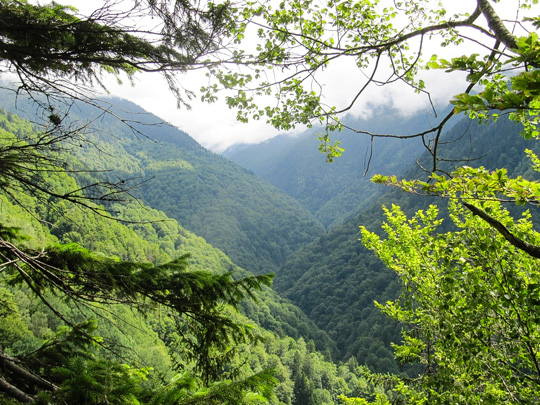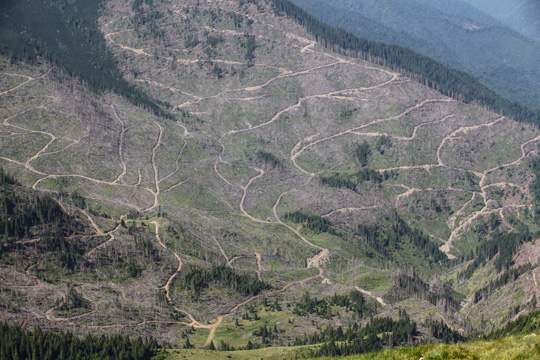The last virgin forests in Europe
Freiburg, Sep 16, 2021
A team led by Prof. Dr. Albert Reif presents a comprehensive study on the importance, situation and future of virgin forests in Romania. In it, the researchers analyze how Romanian state institutions act to protect virgin and old-growth forests, and explain the situation in the forestry and timber sector that has developed in the interplay between politics, administration and companies. The authors of the study claim that it must be a pan-European concern to protect the last great primeval forests, as it is formulated as a central element in the European Union’s Biodiversity Strategy 2030.

Large areas of virgin forests still exist in the Romanian Carpathians: The Boia Mica valley in the Făgăras mountains; about 1,000 hectares of wilderness with primary forests in different stages, is home to lynx and bears. Photo: Rainer Luick
eCommerce continues to grow steadily: the demand for wood and packaging material from the mail order business is so great as a result that even the last European rain forests in Romania are threatened by deforestation. Since 1995, Prof. Dr. Albert Reif, who was Professor of Site and Vegetation Science at the University of Freiburg until his retirement in 2018, has traveled to Romania time and again. He contributed his expertise as co-author to the study “Virgin Forests in the Heart of Europe: Importance, Situation and Future of Virgin Forests in Romania.” In this publication, scientists analyze the importance, situation and future of Romanian forests and especially of the virgin forests there. This study was developed in close cooperation with Prof. Dr. R. Luick from the University of Applied Forest Sciences Rottenburg and other researchers.
Demand from abroad
27 percent of Romania's land area, or 6.4 million hectares, is forested. About 3.4 million of it is state-owned. In recent years, many forests have been returned to their former owners as private or church-owned forests, while others have been privatized and often sold for less than their value. Particularly following the country’s entry into the EU, demand from abroad has grown, explains the Freiburg researcher. Huge sawmills from international companies have settled near the Carpathians, which have a high demand for wood.
In its forests, Romania harbors a large part of the remaining primeval forests of the temperate climate zone of Europe. It is estimated that virgin forests and virgin forest-like populations cover an area of between 100,000 and 300,000 hectares today; about 20 years ago, their areas were about twice as large. The fact that virgin forests still exist at all is also due to political reasons: Many of these forests are remote. In the past, it was too costly to open them up with roads; in addition, the technical means were lacking. Until the so-called “Change” in 1990, the virgin forests were under strict protection, and every offense was prosecuted. With the collapse of communism and the loss of state control, not only did power saws and circular saws enter the country, but a gold-digger mentality prevailed. “People were grabbing at everything in sight,” Reif says.
Illegal deforestation
According to the Romanian Forest Code of 2012, all virgin forests and virgin forest-like populations are protected, but to date there is no valid virgin forest mapping of the country. If forest areas are reported in order to be recognized as virgin forest or virgin forest-like populations, the regional forestry authority must certify this. However, since this is contrary to the desire for timber exploitation, these reported forest areas are very rarely recognized. The state forestry authority discouraged research from non-governmental organizations to map existing virgin forest by refusing to provide data or hindering their efforts through complex permission procedures. These studies are therefore based primarily on the evaluation of internationally available data such as satellite images instead of terrestrial inventories on site. Accordingly, the existing studies are riddled with errors, but there is a lack of alternatives, explains Reif.

Especially after Romania joined the EU in 2007, large-scale logging in the Romanian Carpathians increased dramatically. This area of the Southern Făgăras Mountains previously were covered by extended virgin and old-growth forest. Now the steep slopes become sensitive to erosion. Photo: Christoph Promberger / Fundația Conservation Carpathia
The timber business is a lucrative one. If forests are used illegally, the state loses tax revenue. In the years between 1990 and 2011, about 80 million cubic meters of wood were illegally felled, the Freiburg researcher calculates. Quantifying such illegal logging is difficult. Reif cites an estimate by the European Union’s agricultural commission for the period between the years 2014 and 2017, which amounts to 8.7 million cubic meters of illegally felled timber per year. Photos from the study show slopes completely free of trees, such as those in the Făgăras Mountains in southern Carpathia, despite a ban on clear-cutting. For example, around 2017, several thousand hectares had been clear-cut in a short period of time, with all the negative consequences for the eroding soil and the input into water bodies.
Important CO₂ repositories
However, the new study has no political intention, explains Reif: “It is rather a plea for the last preserved virgin forests we have in Central Europe.” Their importance is internationally recognized; the beech forests of the Carpathians are a Unesco World Heritage Site. “Virgin forests contain a diversity of species and a gene pool that has not been altered by selective human intervention. If species disappear, they won’t be coming back anytime soon,” Reif explains. “Our commercial forests almost completely lack this unbroken habitat tradition. Add to that their importance as CO₂ repositories and as reference ecosystems in the face of today’s environmental changes.”
But Romania, says the researcher, is not only a perpetrator but also a victim in the overexploitation of forests and the destruction of some primeval forests. “Because in Germany, too, the timber industry and science are calling for increased use of wood as a renewable raw material. This sounds plausible at first.” However, this demand becomes dangerous when this is played off against the protection of the biodiversity of the virgin forests, i.e. when environmental protection is prioritized over nature conservation. “You can’t play these different interests against each other,” Reif says with conviction. “Commercial forests and forest reserves must coexist and be accepted. Protected forest areas must not be allowed to fall by the wayside because of increasing demand for ever more biomass use. We need sustainable resource use and a society that strives for balance.”
Annette Hoffmann

